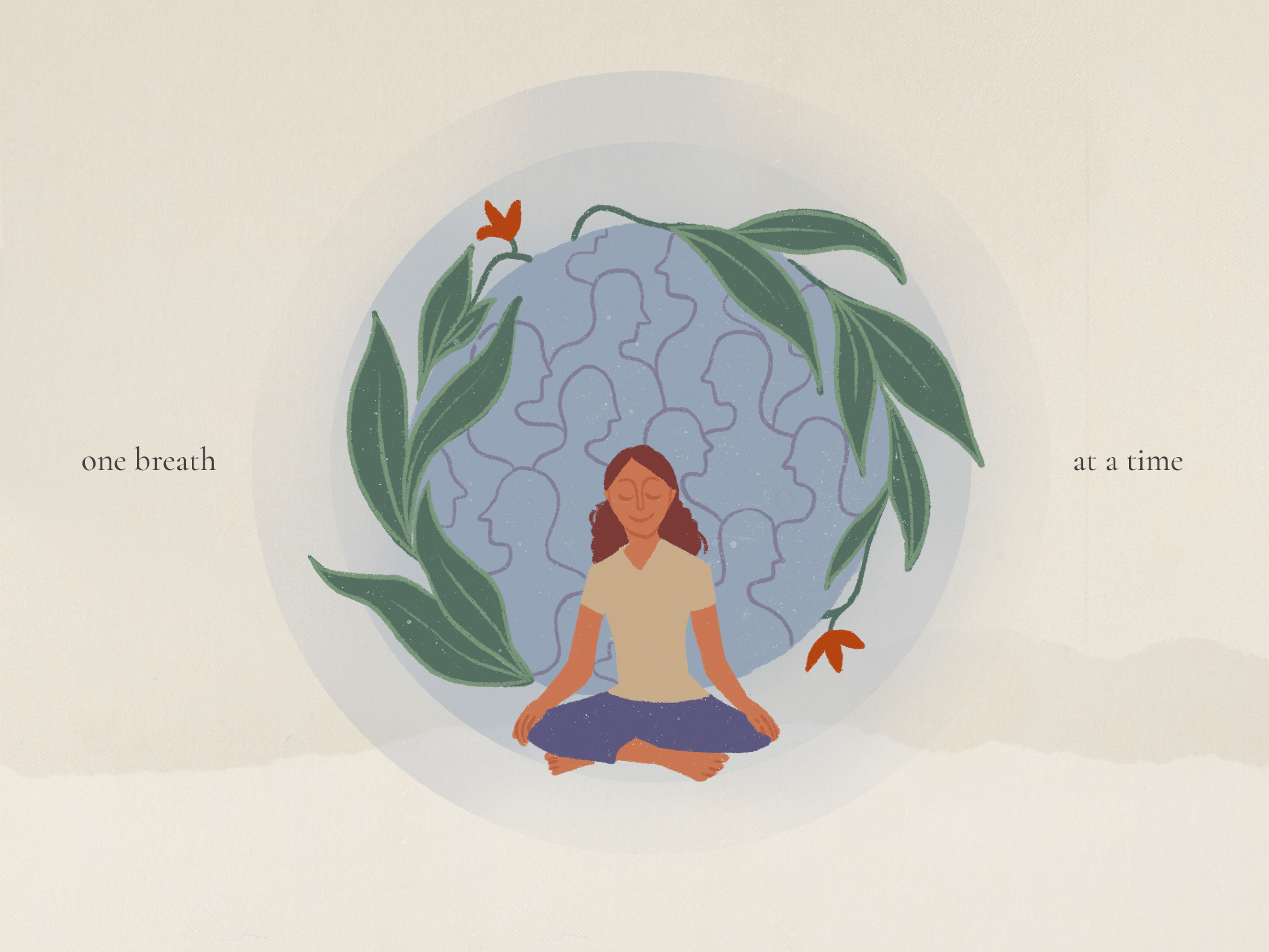
Written by Diva Garg
Illustrated by Himanshi Parmar
“If you want to conquer the anxiety of life, live in the moment, live in the breath,” said Amit Ray, author, and spiritual master.
Mindfulness is a term that we have all been hearing more and more recently. So, what is mindfulness? Where do mindfulness practices originate from? How does mindfulness help us live our lives better? Can everyone practice mindfulness? We dive into the realm of mindfulness to help you understand the simple ways to integrate it into your life. We are conducting various events that incorporate mindfulness here at Puranik Foundation! Check them out on our website.
WHAT IS MINDFULNESS?
Mindfulness, as the word itself suggests, is a state when the mind is fully attending to our current reality and being completely present. Though the word suggests focusing only on the mind, mindfulness is being acutely aware of your body, mind, and spirit. It is a human ability that everyone can possess but a skill that needs to be practiced to better access it.
Mindfulness is when we are aware of where we are, what we are doing, and how we feel as well as how we affect our community and the environment around us. An attempt to create a state in which we are always present- really present- in every action, in every moment.
.png)
It is often hard to describe mindfulness in its entirety but it is known to have 3 underlying elements; being completely aware, being non-judgmental, and being non-reactive.
Being Completely Aware
A state of being fully conscious and aware of our present moment, emotional and mental states, our whole being, others around us, how we interact with them and our surroundings, and the context in which they occur.
Home composting is one of the ways for individuals to contribute towards a more sustainable planet by reducing waste and one’s carbon footprint. The other benefits of composting are:
.png)
Being Non-Judgemental
A state of understanding and knowledge of everything being as is, and accepting rather than attaching attributes such as ‘good’ ‘bad’ ‘right’ ‘wrong’. It is a process of letting go of our unique perception of the world and being able to observe it and ourselves from a more objective perspective.
Being Non-Reactive
The ability to pause between stimuli that are presented to us and our reactions. Mindfulness practice helps create space between stimuli and response and a sense of calm so we can act in accordance with our inherent values rather than react mindlessly.
.png)
Mindfulness is a way of living, integrated into our daily lives. While there are particular practices that help us elevate our mindfulness, the key is to be able to integrate those principles into our lives and live through them. For example, experiencing life with mindfulness through mindful eating, mindful listening, or mindful speaking.
Mindfulness cultivation involves asking questions of ourselves, being non-judgemental, reflecting on the how and why, finding comfort with the uncomfortable, acting in cohesion with our values, constantly seeking equilibrium.
Mindfulness is not just a process for ourselves. It is a process that also affects our community and the environment. By being a more mindful and caring human being, we are able to better affect our surroundings. Being mindful causes a ripple effect that has significant outcomes.
What does mindfulness do for the Self?
- Becoming aware of our emotional, mental, and physical states of being
- Understanding our values and principles
- Being more present in, and going deeper into, understanding ourselves
What does mindfulness do for the Community?
- Seeing and accepting people as they are and understanding their actions/reactions without reacting unconsciously or judging them
- Forming authentic relationships where we are present to give and receive
- Building trust within our community and creating an environment of understanding, receiving constructive feedback, accepting of growth and change, and interdependence
What does Mindfulness do for the Environment?
- Understanding how every element of nature, including us and our actions, are interdependent and interact with and affect one another
- Understanding ourselves as natural beings and learning key lessons from nature
- Appreciating our environment in all its beauty, order, and disorder

WHERE DOES MINDFULNESS COME FROM?
Mindfulness can trace its origins back thousands of years to ancient Buddhist practices of Vipassana meditation, Vedic practices like yoga, or Chinese practices like tai chi.
The modern Western world was introduced to mindfulness in the 1970s through Jon Kabat-Zinn, an emeritus professor of medicine from the University of Massachusetts, who created a program called Mindfulness-Based Stress Reduction (MBSR). While he was heavily influenced by Buddhist Vipassana meditation, he taught mindfulness secularly.
.png)
The fundamentals of mindfulness have been one of the essential pearls of Eastern wisdom. There is a common thread between all these philosophies and while there have been many different forms of these practices, the root of their purpose has been to elevate the human experience from the endless suffering and be one with ourselves, our community, nature. The philosophy behind these practices also focuses on the process itself being as important as the “end result”. Or rather, the process itself being the end result. This shift in focus develops with mindfulness- to appreciate and celebrate every single moment as a victory.
WHAT ARE THE BENEFITS OF MINDFULNESS?
While it’s important to not fixate on the benefits of our practices and engage with the understanding that the process is as much a goal as the “end” result, we can also recognize and appreciate the benefits of mindfulness. Keeping aside a dedicated time for mindfulness practice can yield many psychological, emotional, cognitive, and physiological advantages. Some of the positive effects are:
- Relieving of stress, anxiety, depression, and insomnia
- Improving and regulating moods
- Increasing awareness, concentration, and attention span by increasing the capacity of our “higher level” human brain
- Lowering blood pressure, reducing chronic pain
Mindfulness helps us connect better to ourselves and the community and environment around us.
.png)
HOW CAN ONE PRACTICE MINDFULNESS?
Mindfulness is both an act as well as a consequence of our practice. While mindfulness is innate, it may come naturally to some, but may take more time to develop in others. Some may prefer to practice in a more structured way that then seeps into everyday life or to apply the principles to daily living. It's essential to really recognize your unique position and not compare yourself to others.
Mindfulness Practice for Self Breathwork
- Sit in a comfortable position with your back straight. This could be on a chair or the floor.
- Place your arms by your knees
- If you prefer to set a timer, set one for a duration that you are comfortable with. The idea is to start slow and steady and build up with time.
- Close your eyes and just take a few minutes to relax.
- Start by recognizing all the sounds around you. The sounds that are far away and the sounds that are close. Just pay attention to all the sounds that you hear.
- Now slowly bring all that attention and narrow it to just the sounds of your breath.
- Expand the attention on your breath, visualize the flow of movement, feel the sensation of your breath through your whole body, hear the sounds of your breath as you inhale and exhale.
- Spend the rest of your time concentrating on the experience of breathing
- Your mind will wander. Let it. When you have realized it’s wandered, bring it back to the breath. Do not judge yourself for wandering. It’s the nature of the mind.
- Remember, it is not about stopping the mind, it’s about being aware of the thoughts in our mind and bringing our attention back to the present, to where we want to focus.
When you are done, come out of this state, gently. Take a second to take the world in and create this experience as a launchpad for the rest of your day.
Mindfulness Practice for Community
Aim to practice mindfulness in your life by interacting with awareness and empathy. Some exercises that you can practice:
- Interact with the people around you with empathy, non-judgment, and genuine listening. Does someone on the road need some help that you can offer? How do you change your conversation patterns while interacting with strangers if you come from a place of awareness and empathy?
- Meet a friend and create space for your friend with the principles of mindfulness. Put your phone away, listen with genuine interest and try to hear every word, rather than go into your own thoughts, ask questions and be fully present with them.
Mindfulness Practice for Environment
Go out for a slow walk in nature. Walk slowly with the presence of your current surroundings. Notice the trees, the leaves of the trees, the sun coming through them. Notice the patterns. Notice the insects and how they keep themselves busy. Take time out to really see, hear, feel and smell all the different aspects of our natural world that we are a part of. The idea of this walk is not to get anywhere but to appreciate and recognize the abundance around us.
Mindfulness has an abundance of benefits and it has been proven to enrich lives. However, it is important to recognize that mindfulness practices cannot be looked at as the cure to all of our problems. It may in fact make you more aware of the aspects that need work and change within you. No practice without action is beneficial so one must take the practice and the principles and put it into action in daily life and all our relationships.
It is also important to just be able to enjoy and appreciate life. Finding balance is key and if often you need to do things in total abandonment, jump, dance, or go for a sprint, allow yourself, engage and appreciate the bliss! Being aware doesn’t mean being stuck in your head, it means connecting deeper with your mind and body.
We hope this has been an informative guide to begin your journey with mindfulness and connect deeper within. To take this further, connect with us at our various events that integrate mindfulness. We would love to hear how mindfulness practice has had a significant impact on your life. Please share with us on our social media platforms!
.png)